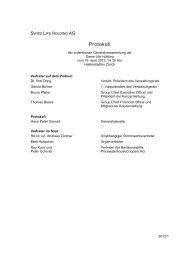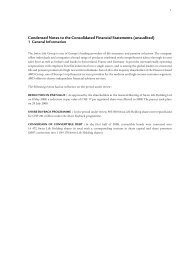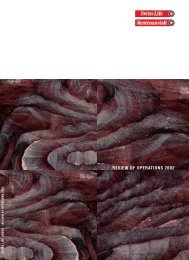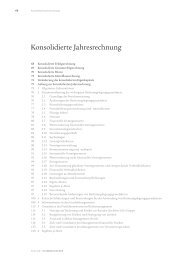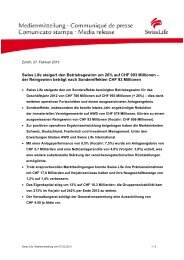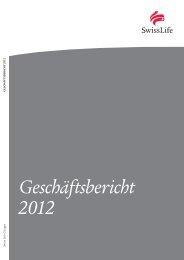Annual Report 2012 - Swiss Life
Annual Report 2012 - Swiss Life
Annual Report 2012 - Swiss Life
Create successful ePaper yourself
Turn your PDF publications into a flip-book with our unique Google optimized e-Paper software.
87 Market Consistent Embedded Value (MCEV)<br />
CERTAINTY EQUIVALENT VALUE (CEV)<br />
The certainty equivalent value is defined as the present value of the future shareholders’ statutory<br />
profits (net of tax) under the certainty equivalent scenario.<br />
In this particular scenario, future market returns are determined as the forward rates implied in the<br />
reference rates at the valuation date. Discounting is performed at the same reference rates. The certainty<br />
equivalent value includes that part of the value of financial options and guarantees which materialises<br />
in the underlying scenario.<br />
The rules for anticipated management and policyholders’ actions applied in the certainty equivalent<br />
scenario are the same as those for the stochastic projection used to determine the time value of financial<br />
options and guarantees.<br />
TIME VALUE OF FINANCIAL OPTIONS AND GUARANTEES (TVOG)<br />
The certainty equivalent value does not allow for the risk that the financial outcome for shareholders<br />
could differ from the one implied by the certainty equivalent scenario. This is of particular relevance<br />
when products or funds include guarantees or options for the policyholder such as:<br />
– guaranteed interest rates<br />
– discretionary profit sharing and regulatory constraints, e.g. “legal quotes”<br />
– maturity guarantees<br />
– guaranteed minimum death benefits<br />
– guaranteed annuity options<br />
– surrender options<br />
For such products or funds, a stochastic projection has been run allowing for the range of possible<br />
scenarios for financial markets. The TVOG is calculated as the difference between the average present<br />
value of shareholder cash flows (profits or losses) and the certainty equivalent value, plus the cost for<br />
credit risk (see remarks on credit risk below). The TVOG therefore represents the additional market<br />
consistent value of those financial options and guarantees in excess of the intrinsic value which are<br />
already allowed for in the certainty equivalent value.<br />
At the end of the projection, shareholders are assumed to meet any shortfall of assets against liabilities<br />
or to receive a share of any residual assets. The same applies to the certainty equivalent value.<br />
The cost of credit risk accounts for the shareholder’s share of credit risk of investments in bonds that<br />
would have otherwise been unaccounted for in other MCEV components. It is defined as the present<br />
value of charges on the projected economic capital for credit risk.<br />
The initial economic capital for credit risk is defined as the impact on the value of in-force business<br />
corresponding to the 99% expected shortfall of the credit loss from the actual bond portfolio over one<br />
year, due to the migration and default risk. The underlying credit risk calculations are performed<br />
using an internal model based on the Credit Metrics ©2 methodology.<br />
2<br />
Copyright © 2009 JPMorgan Chase & Co. All rights reserved.<br />
<strong>Swiss</strong> <strong>Life</strong> – <strong>Annual</strong> <strong>Report</strong> <strong>2012</strong>



